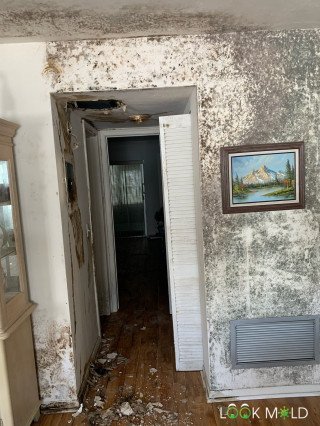Common Types of Mold Found In Your Home
Expert insight by: Brad Fishbein, Licensed Mold Assessor
Updated April 9, 2025
As a Licensed Mold Assessor, I’ve seen mold in every color of the rainbow — and yes, color really does matter.
While mold color alone doesn’t always determine its toxicity, it can give you valuable insight into what kind of mold you’re dealing with, how dangerous it is, and what to do next.
💡 Want to learn how to confirm mold in your home?
👉 Start here with mold detection basics
👉 Explore mold testing options
🖼️ Visual Guide: What Different Types of Mold Look Like
Here’s how to visually identify common household mold colors. Note: appearance alone can’t confirm if mold is toxic, but it helps narrow it down.
| Mold Type | Color / Texture | Common Locations |
|---|---|---|
| Black Mold | Dark green to black, slimy | Drywall, ceilings, wood, insulation |
| White Mold | Fuzzy, powdery, or chalky | Crawlspaces, basements, wooden studs |
| Green Mold | Fuzzy, velvety, often patchy | Bathrooms, windows, food |
| Orange Mold | Gel-like, orange-pink tint | Shower seals, toilets, under sinks |
| Yellow Mold | Dry, dusty, mustard-colored | Wallpaper, HVAC units, wood |
🎨 Mold Colors and What They Mean
Black Mold
Stachybotrys chartarum is the infamous “toxic black mold.” It’s slow-growing, thrives on cellulose-rich materials like drywall, and produces potent mycotoxins. Always treat black mold as a serious health hazard.

White Mold
White mold can appear powdery or fuzzy and is commonly found in crawlspaces, basements, and on wood. It’s often confused with mildew and may change color as it matures.
Green Mold
Often caused by Penicillium, Aspergillus, or Cladosporium, green mold is fast-growing and shows up on drywall, carpets, or spoiled food. While not always toxic, it’s aggressive and allergenic.
Orange Mold
Slimy and bright, orange mold is usually Acremonium. It grows in dark, wet areas like behind walls and on insulation, especially after long-term leaks.
Blue Mold
Caused by Penicillium species, blue mold appears on fruits, bread, or water-damaged building materials. It can produce the toxin patulin and should be avoided.
Red Mold
Mold species like Neurospora, Rhodotorula, and Aspergillus can appear red. It often grows in bathrooms or on food, especially when ventilation is poor.
Grey Mold
Commonly associated with Botrytis cinerea, grey mold thrives in cool, damp environments like plant matter, wallpaper, or cold corners of the home.
Purple Mold
Purple mold is rare but may appear on fabric, insulation, or decaying materials. It could signal Fusarium or Chaetomium, both of which can produce mycotoxins.
Pink Mold
Usually not a mold at all, pink “mold” is Serratia marcescens, a bacteria found in bathrooms and wet areas. It still poses health risks and should be cleaned promptly.
Yellow Mold
Dry rot fungus like Serpula lacrymans, along with Aspergillus and Epicoccum, can cause yellow mold. It grows on wood, insulation, and spoiled food and may be crusty or slimy.
🔬 Most Common Indoor Mold Species
These are the mold genera you're most likely to encounter during an inspection or remediation.
🧫 Penicillium
Found on food, fabrics, and water-damaged drywall, Penicillium is fast-growing and can produce allergens or mycotoxins.
- Colors: Blue, green, white
- Grows on: Furniture, walls, food, insulation
👉 See Penicillium-related green mold
🧫 Aspergillus
One of the most common indoor molds. Found in HVAC systems, insulation, and wet fabrics, and known to cause allergic reactions and respiratory issues.
- Colors: Yellow, green, brown, black
👉 Read more about Aspergillus and black mold
🧫 Alternaria
Common in bathrooms, windowsills, and wet areas, Alternaria spreads quickly and is highly allergenic.
- Colors: Dark green, brown, gray
👉 Compare with white and grey mold
🧫 Stachybotrys (Black Mold)
The most infamous indoor mold. It requires prolonged moisture and grows on drywall, ceiling tiles, and wood. Produces dangerous mycotoxins.
👉 Learn how to identify toxic black mold
🧫 Chaetomium
Chaetomium is often found after water intrusion, especially in wall cavities and on subfloors. It can look greyish or black and may smell musty.
👉 See how it relates to purple mold
🧫 Cladosporium
Grows on dusty surfaces, leather, vents, and fabrics. Not toxic, but a strong allergen.
👉 Compare with green mold found in HVAC systems
🧫 Fusarium
Grows even in cool environments, and can spread rapidly through fabric, carpet, and food. Often pink or purple in appearance.
👉 Learn about Fusarium-related pink and purple mold
🧫 Trichoderma
Thrives on wet wood, insulation, and wallpaper glue. Known for its destructive capabilities and mycotoxin production.
👉 See Trichoderma growth in green and white mold
🧫 Memnoniella
Closely related to Stachybotrys and often mistaken for it. Found in wall cavities, paper, and insulation.
👉 Learn the difference between Memnoniella and black mold
🧫 Ulocladium
Grows in flood-damaged areas and requires heavy water exposure. Can often be a marker of past serious leaks.
👉 Compare Ulocladium and grey or black mold
✅ Final Thoughts from Brad
Color isn’t everything — but it’s often your first clue that mold is growing somewhere it shouldn’t.
If you spot any of the above in your home:
Don’t wait — the longer mold grows, the more damage it does.
Explore Related Topics:

Meet the author: Brad Fishbein is an ACAC council-certified Microbial Investigator. In the fall of 2012, he became a Licensed Mold Assessor in the State of Florida through the Department of Business & Professional Regulation. Brad has helped homeowners with over 5,000 successfully completed Mold Inspections since 2009.

